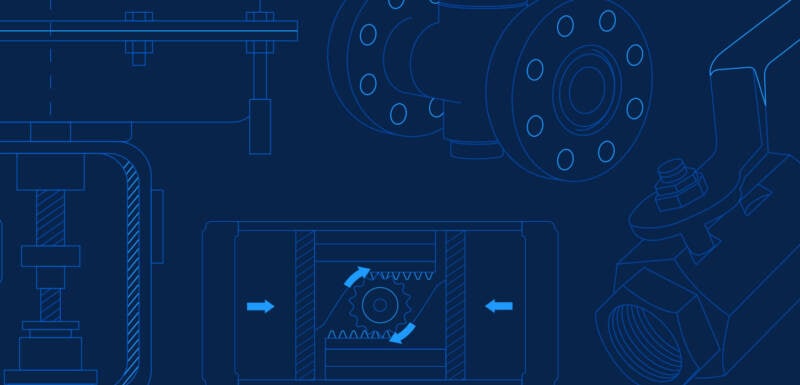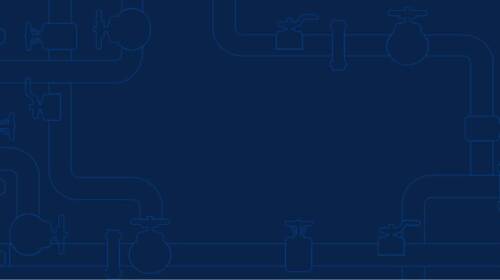Types of Valve Actuators 101: Which Is Right For You?

Valves are a critical component in process control applications, where they are used to control the flow of liquids and gasses by opening, closing or partially obstructing the flow.
As industrial automation and control systems have advanced, so too have the methods for controlling valves. Today, many businesses rely on automated valve solutions to position their valves without requiring manual operation. These valves utilize pneumatic, electric or hydraulic actuators to provide precise and reliable control of valve position, making them an integral part of many piping systems.
But with so many types of valve actuators available on the market, it can be challenging to determine which one is right for your specific application. Continue reading for an overview of the most common types of valve actuators, so you can make an informed decision when selecting the best one for your needs.
What Is a Valve Actuator?
A valve actuator is a device used to cycle a valve in order to control the movement of liquids and gasses inside a pipeline. They are useful in applications where the valve is not easily accessible to operate manually, in high-cycle applications where manual operation would not be practical or in control applications where the valve is required to precisely regulate the flow of materials.
These mechanical devices use an outside power source to position the valve to the desired position. There are three main power sources used in valve actuation:
- Pneumatic
- Electric
- Hydraulic
Each power source provides the necessary energy to move the valve’s closure element to the target position.
Generally speaking, valve actuators come in two main types:
- Rotary valve actuators, which work by rotating the valve stem
- Linear valve actuators, which move the valve stem linearly
Choosing the right type of actuator is dictated by the type of valve you are using for your project. For example, rotary valves — such as ball valves or butterfly valves — will require a rotary actuator, whereas linear valves — such as gate valves or globe valves — will require a linear actuator.
Pneumatic Actuators
Pneumatic actuators are used in a wide variety of applications and are favored for their fast cycle times and durability. They use compressed air to create the force needed to operate the valve. Pneumatic actuators can deliver the required amount of force with a sufficient speed of travel for most applications, making them a popular choice for process control applications.
Pneumatic actuators are available in both double-acting and spring-return configurations, with the latter providing a fail-safe response to the loss of power or air.
Pneumatic actuators are inherently safe against explosion hazards. However, it is important to note that they are often paired with integral solenoid valves (commonly referred to as pilot valves). Unlike the actuators they pilot, these solenoid valves are not inherently explosion proof, though explosion-proof models are widely available.
When selecting a pneumatic actuator for an application that requires an explosion-proof design, it is important to choose an explosion-proof solenoid valve to pair with it or to use a solenoid bank or remote pilot solenoid valve. This enables the solenoid valve to be housed remotely in a safe location.
Pneumatic actuators are available in various designs, including the following.
- Piston: Suitable for applications requiring high thrust and high speed
- Diaphragm: Ideal for applications requiring compact size and low air consumption
- Rotary vane: Useful for applications that require the rotation of the valve stem by 90 degrees
When selecting a pneumatic actuator, it is important to consider the specific requirements of your application. This includes factors such as valve size, air supply pressure and environmental conditions. Proper selection will ensure that the actuator provides reliable operation and optimal performance.
Electric Actuators
Electric actuators are a popular choice due to their reliability and ease of use. Unlike pneumatic and hydraulic actuators, electric actuators do not require fluid or compressed air power to operate. They use an electric motor to move the valve in a linear or rotational motion. Electric actuators are used in a variety of commercial and industrial applications. Modular electric actuators are also widely available and are commonly used to enable continuous positioning control.
Electric actuators are popular in industries such as power generation, water supply and treatment plants and the pharmaceutical industry. They are also preferred for applications where air quality is a concern, as they do not produce any exhaust.
However, electric actuators can be more expensive than other types of actuators and require a reliable power source. They may also be unsuitable for applications in hazardous or explosive environments.
Hydraulic Actuators
Hydraulic actuators use liquid pressure to make the valve mechanism move. This type of actuator can produce a tremendous amount of mechanical force, which makes it well-suited for large isolating valves on gas pipelines. Most hydraulic actuators use a piston instead of a diaphragm to turn fluid pressure into mechanical force. This results in steady and reliable positioning, as hydraulic oil is relatively incompressible.
In some cases, hydraulic and electric power are combined to create electro-hydraulic valve actuators. This type of actuator consists of an electrically driven hydraulic unit that supplies pressurized fluid, a well-mounted actuator and a linkage to the valve stem that includes a hand wheel for manual override.
Electro-hydraulic actuators are best suited for isolated locations where pneumatic supply pressure is unavailable but accurate control of valve plug position is necessary.
Hydraulic actuators are often used in situations where the valve must be moved against high pressure, high temperatures or other high-intensity conditions. Because hydraulic actuators are able to generate so much force, they are instrumental in scenarios where the valve is required to respond quickly, such as in emergency shut-off applications.
Control Valve Actuators
Control valves are most commonly paired with electric actuators but can utilize any of the three power sources (electric, pneumatic or hydraulic). These actuators specialize in providing precise, modular valve position control. They may respond to signals from a variety of sources, including a manual switch, a controller or a computer, and these signals move the valve to the specified position accordingly.
Control valve actuators serve several key functions:
- Position Control: Shifting the valve’s closure component to the position designated by the control signal
- Position Feedback: Control actuators utilize position feedback mechanisms to accurately and precisely communicate the valve’s position to the control system.
- Cycle Speed Control: Most control actuators can control the speed at which the valve cycles, this allows for more controlled operation and can help mitigate issues such as water hammer.
Choosing the correct valve type for your specific application is essential, as selecting the wrong valve actuator can lead to decreased uptime, increased maintenance costs and safety risks.
Comparing Valve Actuator Types
The table below provides a quick comparison of the different types of valve actuators:
| Valve Actuator Type | Advantages | Disadvantages | Typical Applications |
| Pneumatic |
|
|
|
| Electric |
|
|
|
| Hydraulic |
|
|
|
Note: This table is not exhaustive and is intended to provide a general comparison of the advantages and disadvantages of each type of valve actuator. It’s important to consult with a qualified valve expert to determine the best type of valve actuator for a specific application.
Understanding the different types of actuators and when to use them is crucial to ensuring the optimal performance and longevity of your control processes. Selecting the right valve actuator can increase the safety of your piping systems, reduce maintenance costs and improve uptime.
Want to learn even more about valve actuators and which is best for your next project? Check out our Complete Guide to Valve Actuators — it’s filled with helpful tips and detailed information that will put you on the right track.
Valve Sizing 101: Your Blueprint for Effective Flow Management
Discover how strategic valve selection impacts flow control processes.




